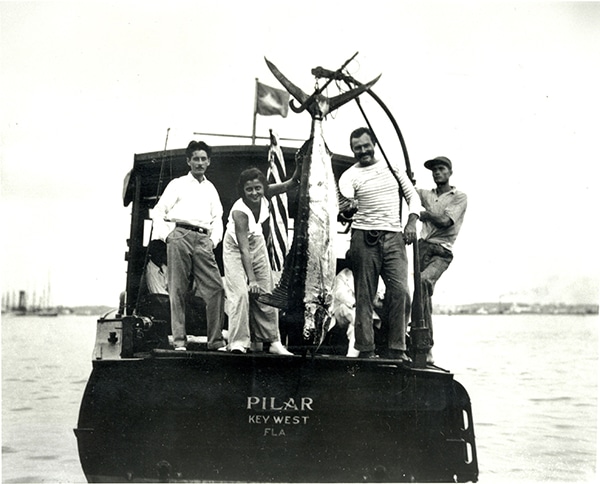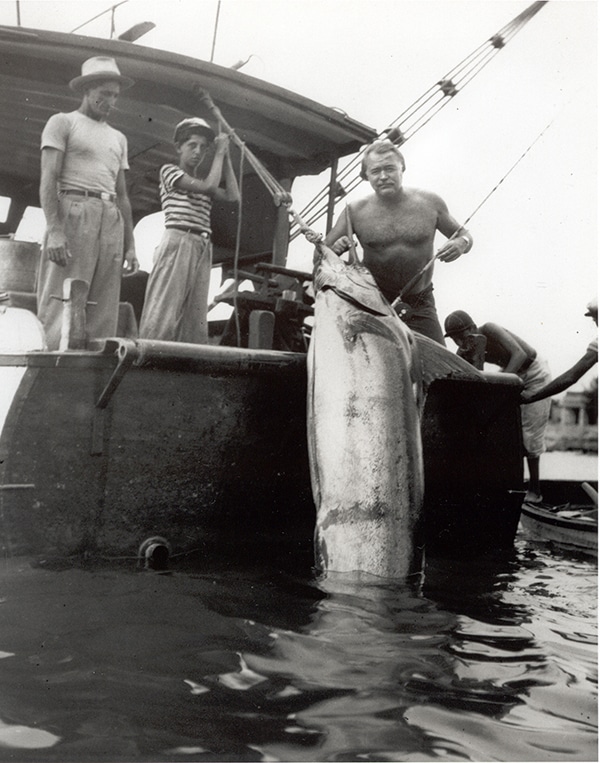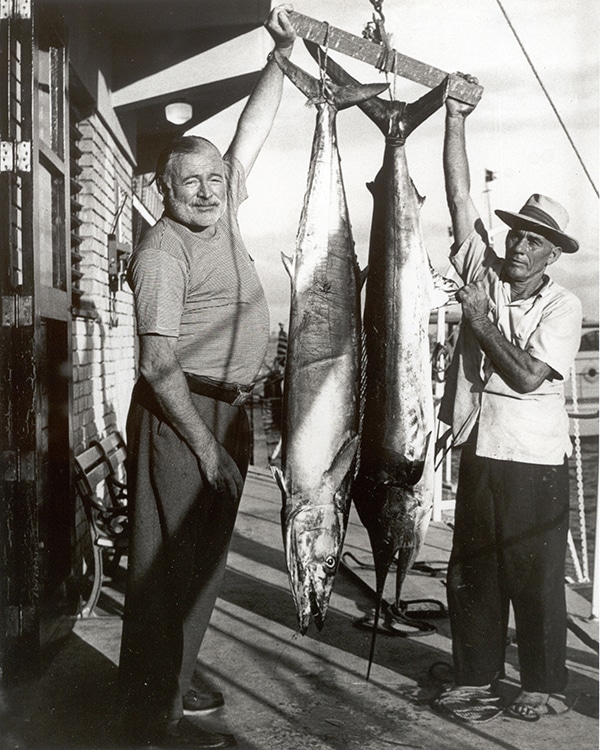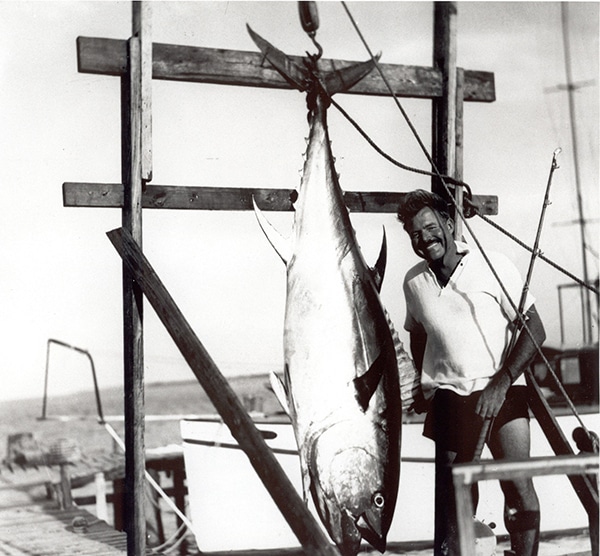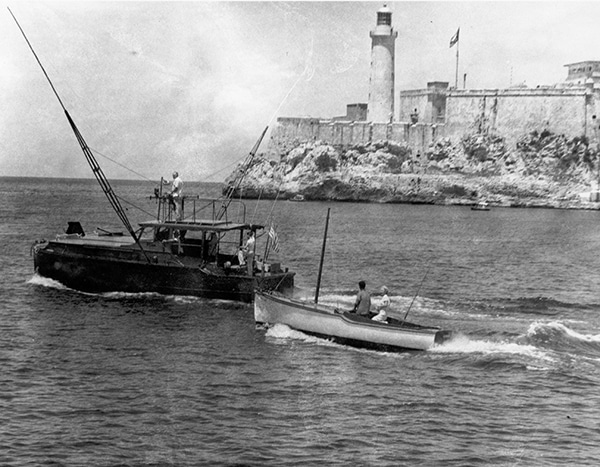The International Game Fish Association (IGFA) will soon be celebrating its 75th year as the fishing world’s keeper of records and the international standard setter for proper game-fishing practices. Indeed, the IGFA once sent Ernest Hemingway to Kona just to check on Kona fishing methods in connection with a world record application. Here’s the story from the earliest days of the IGFA and the early years of “sport fishing,” here.
Pioneering Kona skipper Charlie Finlayson invented a fighting chair that could have revolutionized big game fishing. Ernest Hemingway flew to Kona to see it, hated it, and complained to the IGFA about it. As a result of the author’s criticism, Charlie’s fishing chair ended up on the scrap heap of fishing history and the IGFA became wary about what was going on way out here in the middle of the Pacific.
The IGFA was in its infancy – barely two years old – in February 1941 when the famous writer made his only visit to Hawaii. He had stopped in Honolulu on his honeymoon with new bride Martha Gellhorn before heading on to China.
While Hemingway was in Honolulu, he met attorney Dudley C. Lewis, president of the Hawaii Big Game Fishing Association, IGFA trustee and later one of the six founders of the Hawaii International Billfish Tournament. Hemingway was involved in the IGFA at its beginning, and Dudley asked him to assist in verifying a Kona catch that Charlie had submitted to the IGFA for record consideration.
IGFA founders Michael Lerner and S. Kip Farrington Jr. had fished off Waianae with Dudley prior to its founding in 1939 and greatly respected his authority, fishing standards and sense of ethics.
Charlie had submitted a record application for an 815-pound “black marlin,” which had been caught by Robert Clapp, one of his charters aboard his boat.
Most marlin here were called “blacks” even though they were most likely blues, because the blue marlin was not recognized as a Pacific species back then. But blacks that big and bigger have been caught here. Setting aside the specific identity (it would not have mattered back then), Dudley had asked Hemingway to examine the remains of the fish, which had been sent over to Honolulu and stored in an ice house there. Hemingway would have been able to get a bare bones size estimate from the pieces on display – mostly the head, tail and skin – but nothing definitive.
What Hemingway saw interested him enough to fly over to Kona to get the story of the catch directly from Charlie’s mouth. So the bride and groom flew off for a two-day sojourn to Kona to do some sleuthing, fishing, sheep-hunting, and sight-seeing.
Whether Hemingway caught anything here seems never to have been recorded. Hemingway, himself, never wrote about his Hawaii fishing trip so it is unlikely that he did catch anything worth writing about. And we have to assume he fished with Charlie on one of the two boats that were part of Charlie’s charter operation.
But he wrote about Charlie’s fishing chair and did so with disdain, indignity and a sense of insult. He put all of his outrage in a letter to Francesca Lamonte, an IGFA founding member and associate curator of the American Museum of Natural History (Lamonte would figure prominently in another of Hawaii’s major sportfishing issues 20 years later but that is a story for later).
That letter, dated July 18, 1941 was sent by the IGFA and makes entertaining reading. If you have read much Hemingway as a writer of fiction, you can still sense some of his literary style in what amounts to a technical description of a piece of mechanical equipment.
You will understand it a bit more if you are familiar with the kind of seat competitive rowers use in racing competitions like the Olympics. The rower’s seat is on wheels in tracks so that he or she can apply maximum strength to the oar by driving the seat backward with the legs. The rower than readies for the next catch by raising the knees and sliding the seat back to the catch position.
Whether or not Hemingway had ever competed as an oarsman the rowing seat is what Charlie’s fishing chair brought to mind.
“The Clapp catch used a fishing chair built something like a rowing seat,” Hemingway wrote in his letter to Francesca. “The rod butt was in a socket which was a part of the chair. The rod and reel were attached to the chair the back of which would be rolled back and forth by the attendant.
“Being attached to the chair the pull of the fish would pull the chair and the rod forward. The guard or attendant would then pull the back of the chair back thus gaining line on the fish which the angler would only need to recover by turning the handle of the reel.”
And here is the part that got Hemingway’s dander up.
“The entire fishing device was designed to make it possible for anglers who had never fished before to catch big fish without being subjected to any strain on any part of their bodies except their reeling hand.”
Needless to say, Hemingway concluded that the seat unfairly advantaged the angler (isn’t that really the point? asks I), and no fish caught using it could be considered legal by IGFA standards. So no black marlin record for Robert Clapp.
I wonder what Hemingway would have said about the now generally accepted bucket seat harness as used in the now standard fighting chair? Without wheels, you get the same to-and-fro sliding effect by soaping the seat.
The difference with Charlie’s seat, of course, is the opportunity for a deckhand to do the work.
I recall seeing Charlie’s contraption long ago but can find no photo to show.
As for the legendary professor Francesca Lamonte, she popped up again in Hawaii fishing history in relation to another supposed “black” marlin.
Professor Lamonte believed there were no blue marlin in the Pacific and considered all record submissions from Hawaii to be blacks. After Capt. George Parker caught a 1,002-pound blue marlin in 1954 on a trip from Kona to Honolulu, he challenged Lamonte’s misidentification. She traveled to Kona, examined the Central Pacific blues up close and reversed her position.
If you want to find out more about Ernest Hemingway’s only visit to Hawaii –and, in particular, his intense dislike for Hawaiian hospitality – look online for a document entitled “Hemingway’s Hawaiian Honeymoon.” Written by author Mark P. Ott, the 4,246-word document was published in the September 22, 1977 issue of The Hemingway Review.
